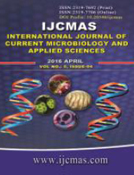


 National Academy of Agricultural Sciences (NAAS)
National Academy of Agricultural Sciences (NAAS)

|
PRINT ISSN : 2319-7692
Online ISSN : 2319-7706 Issues : 12 per year Publisher : Excellent Publishers Email : editorijcmas@gmail.com / submit@ijcmas.com Editor-in-chief: Dr.M.Prakash Index Copernicus ICV 2018: 95.39 NAAS RATING 2020: 5.38 |
Printing presses may cause different pollutants which may have various environmental and health effects upon those occupationally exposed workers. The results obviously showed highest values of lead and zinc blood content in occupationally exposed sample respectively in comparison with the other groups. In contrast, the study recorded highest values of blood copper concentration in environmental exposure samples as a compared with the other groups. Blood parameters indicated to significant decreases of white blood cells concentrations in workers blood which is lower than the control samples. The study found that the hemoglobin, hematocrit and red blood cells concentrations in these samples were decreased in environmentally samples compared to other groups. Also, spirometric analysis shows significant decreased in forced vital capacity (FVC) and forced expiratory volume in one second (FEV1) for occupationally workers .Peak Expiratory Flow (PEF) and maximum mid Forced Expiratory Flow (FEF25-75) shows significant decreased in both of occupationally and environmentally workers as against the control group. The changes in lung function indicate restriction to the lung expansion and obstruction of the airways in printing presses workers. However, the most examined workers have shown several respiratory symptoms specially allergies in both occupational and environmental samples.
 |
 |
 |
 |
 |